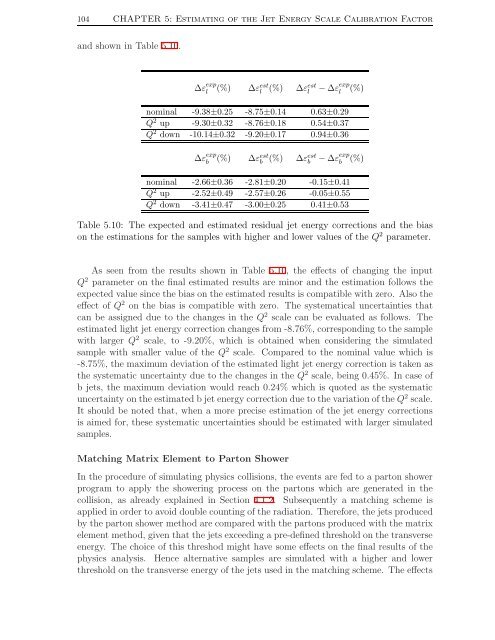Measurement of the Jet Energy Scale in the CMS experiment ... - IIHE
Measurement of the Jet Energy Scale in the CMS experiment ... - IIHE
Measurement of the Jet Energy Scale in the CMS experiment ... - IIHE
You also want an ePaper? Increase the reach of your titles
YUMPU automatically turns print PDFs into web optimized ePapers that Google loves.
104 CHAPTER 5: Estimat<strong>in</strong>g <strong>of</strong> <strong>the</strong> <strong>Jet</strong> <strong>Energy</strong> <strong>Scale</strong> Calibration Factorand shown <strong>in</strong> Table 5.10.∆ε expl(%) ∆ε estl(%) ∆ε estl− ∆ε expl(%)nom<strong>in</strong>al -9.38±0.25 -8.75±0.14 0.63±0.29Q 2 up -9.30±0.32 -8.76±0.18 0.54±0.37Q 2 down -10.14±0.32 -9.20±0.17 0.94±0.36∆ε expb(%) ∆ε estb(%)∆ε estb− ∆ε expb(%)nom<strong>in</strong>al -2.66±0.36 -2.81±0.20 -0.15±0.41Q 2 up -2.52±0.49 -2.57±0.26 -0.05±0.55Q 2 down -3.41±0.47 -3.00±0.25 0.41±0.53Table 5.10: The expected and estimated residual jet energy corrections and <strong>the</strong> biason <strong>the</strong> estimations for <strong>the</strong> samples with higher and lower values <strong>of</strong> <strong>the</strong> Q 2 parameter.As seen from <strong>the</strong> results shown <strong>in</strong> Table 5.10, <strong>the</strong> effects <strong>of</strong> chang<strong>in</strong>g <strong>the</strong> <strong>in</strong>putQ 2 parameter on <strong>the</strong> f<strong>in</strong>al estimated results are m<strong>in</strong>or and <strong>the</strong> estimation follows <strong>the</strong>expected value s<strong>in</strong>ce <strong>the</strong> bias on <strong>the</strong> estimated results is compatible with zero. Also <strong>the</strong>effect <strong>of</strong> Q 2 on <strong>the</strong> bias is compatible with zero. The systematical uncerta<strong>in</strong>ties thatcan be assigned due to <strong>the</strong> changes <strong>in</strong> <strong>the</strong> Q 2 scale can be evaluated as follows. Theestimated light jet energy correction changes from -8.76%, correspond<strong>in</strong>g to <strong>the</strong> samplewith larger Q 2 scale, to -9.20%, which is obta<strong>in</strong>ed when consider<strong>in</strong>g <strong>the</strong> simulatedsample with smaller value <strong>of</strong> <strong>the</strong> Q 2 scale. Compared to <strong>the</strong> nom<strong>in</strong>al value which is-8.75%, <strong>the</strong> maximum deviation <strong>of</strong> <strong>the</strong> estimated light jet energy correction is taken as<strong>the</strong> systematic uncerta<strong>in</strong>ty due to <strong>the</strong> changes <strong>in</strong> <strong>the</strong> Q 2 scale, be<strong>in</strong>g 0.45%. In case <strong>of</strong>b jets, <strong>the</strong> maximum deviation would reach 0.24% which is quoted as <strong>the</strong> systematicuncerta<strong>in</strong>ty on <strong>the</strong> estimated b jet energy correction due to <strong>the</strong> variation <strong>of</strong> <strong>the</strong> Q 2 scale.It should be noted that, when a more precise estimation <strong>of</strong> <strong>the</strong> jet energy correctionsis aimed for, <strong>the</strong>se systematic uncerta<strong>in</strong>ties should be estimated with larger simulatedsamples.Match<strong>in</strong>g Matrix Element to Parton ShowerIn <strong>the</strong> procedure <strong>of</strong> simulat<strong>in</strong>g physics collisions, <strong>the</strong> events are fed to a parton showerprogram to apply <strong>the</strong> shower<strong>in</strong>g process on <strong>the</strong> partons which are generated <strong>in</strong> <strong>the</strong>collision, as already expla<strong>in</strong>ed <strong>in</strong> Section 4.1.2. Subsequently a match<strong>in</strong>g scheme isapplied <strong>in</strong> order to avoid double count<strong>in</strong>g <strong>of</strong> <strong>the</strong> radiation. Therefore, <strong>the</strong> jets producedby <strong>the</strong> parton shower method are compared with <strong>the</strong> partons produced with <strong>the</strong> matrixelement method, given that <strong>the</strong> jets exceed<strong>in</strong>g a pre-def<strong>in</strong>ed threshold on <strong>the</strong> transverseenergy. The choice <strong>of</strong> this threshod might have some effects on <strong>the</strong> f<strong>in</strong>al results <strong>of</strong> <strong>the</strong>physics analysis. Hence alternative samples are simulated with a higher and lowerthreshold on <strong>the</strong> transverse energy <strong>of</strong> <strong>the</strong> jets used <strong>in</strong> <strong>the</strong> match<strong>in</strong>g scheme. The effects
















